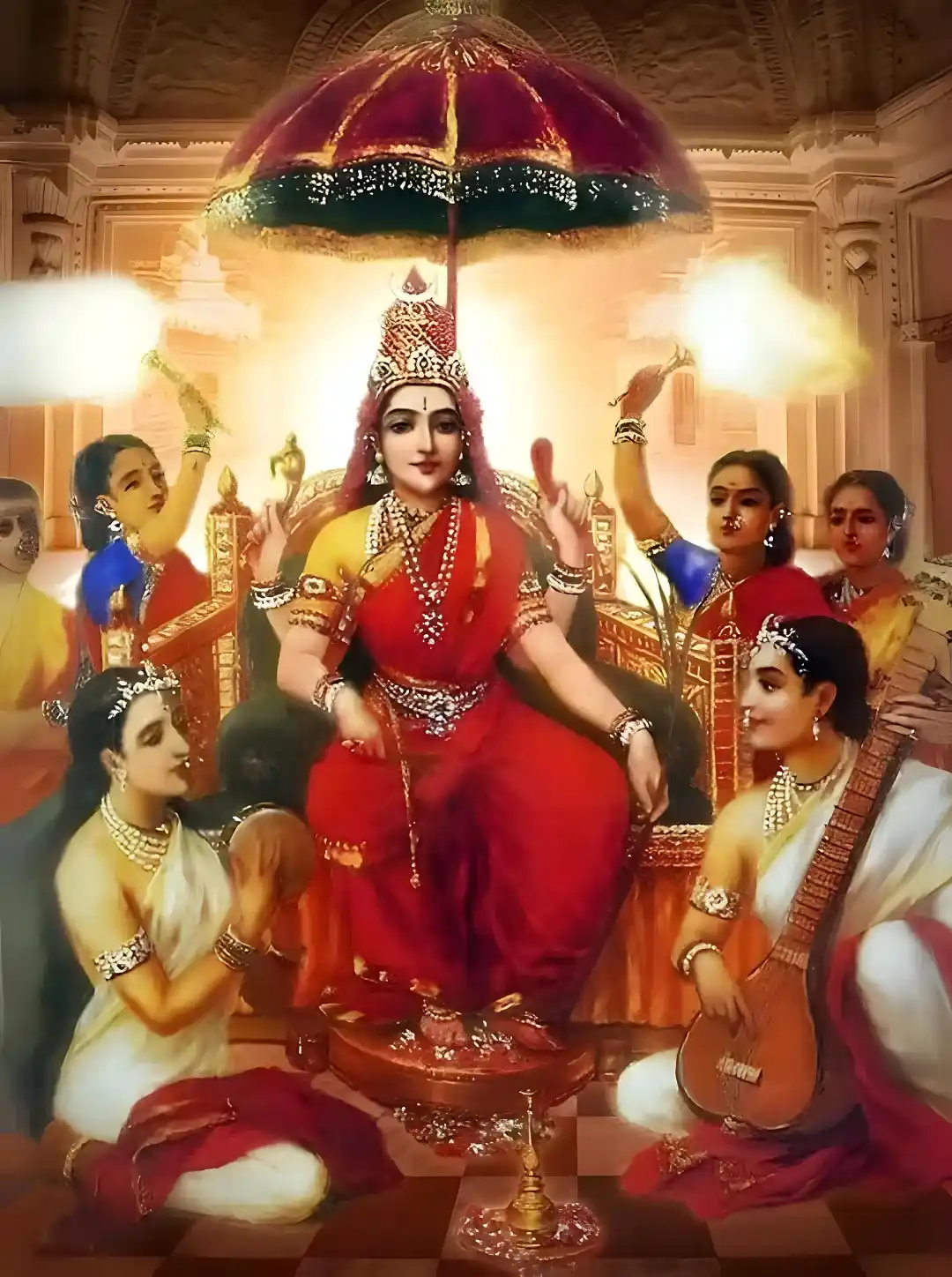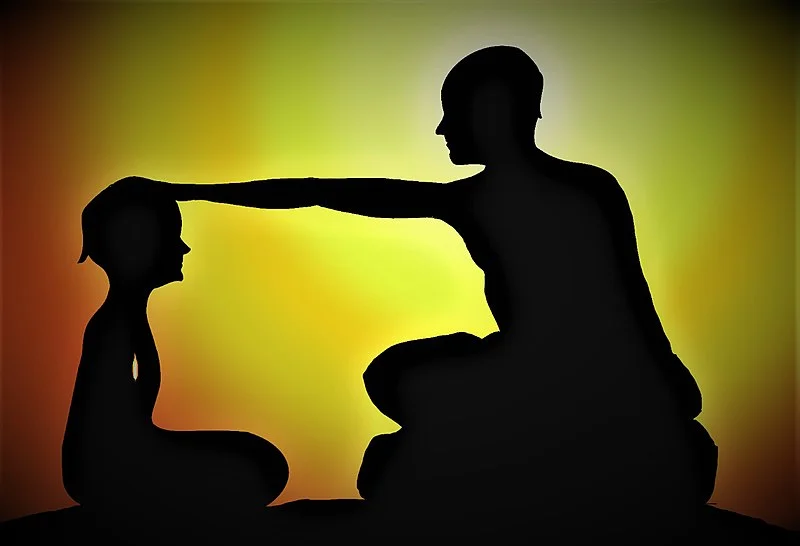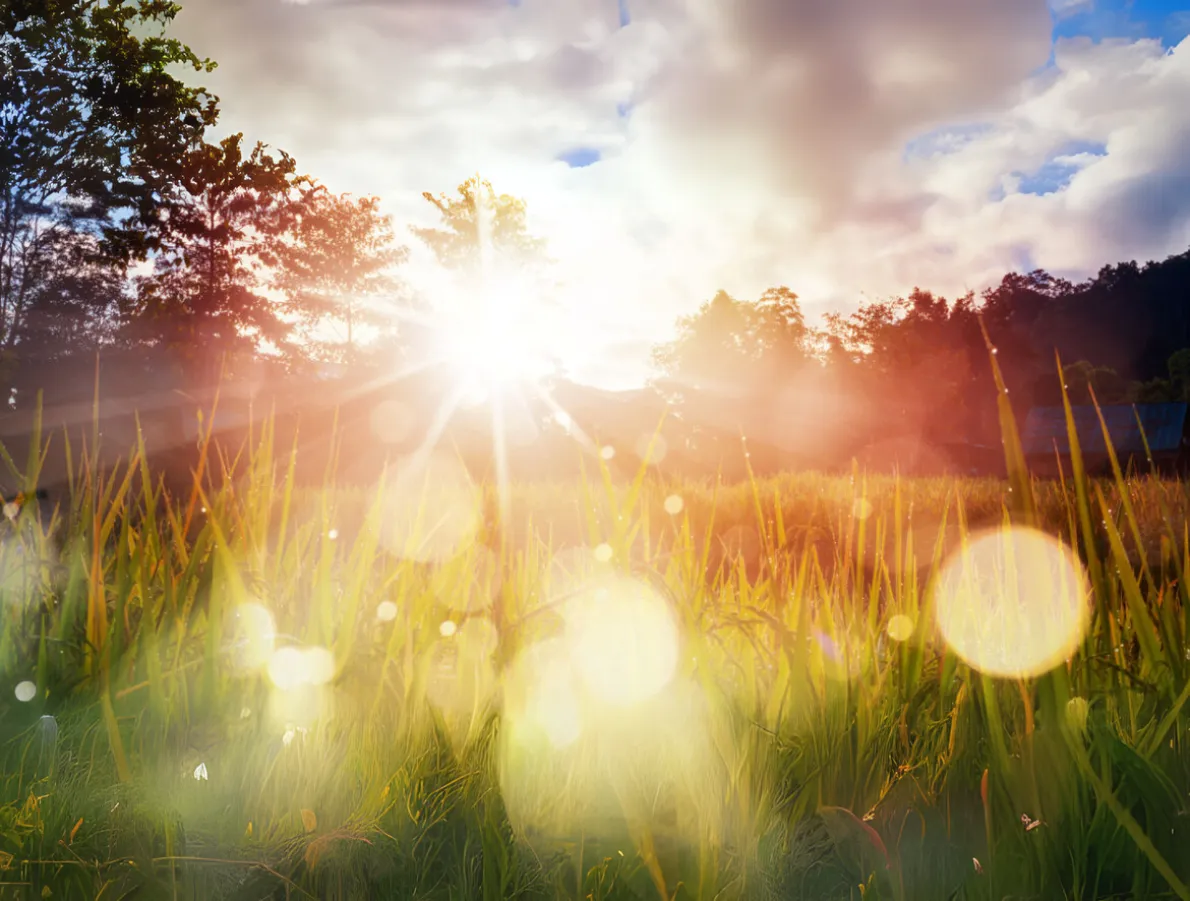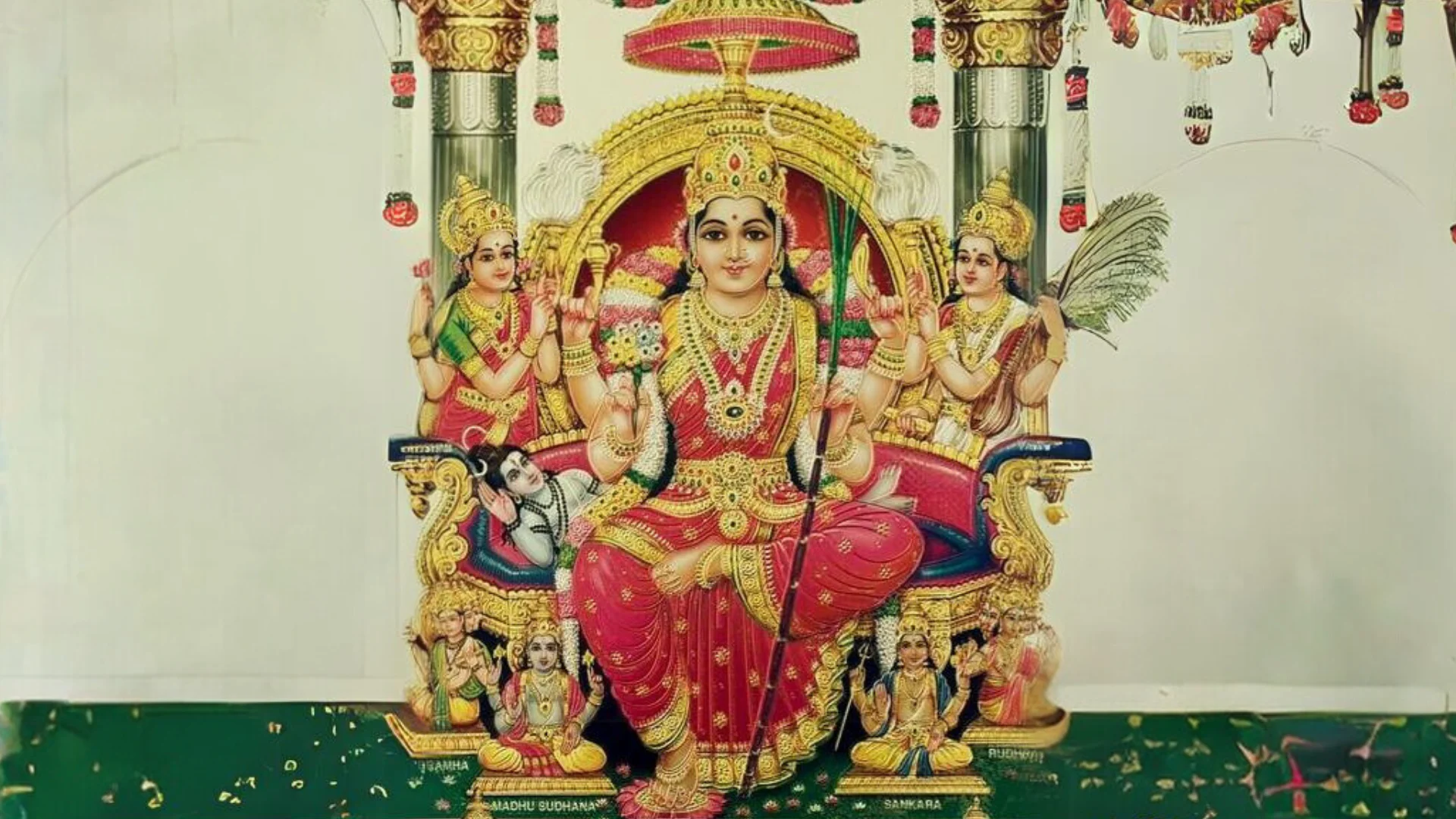Introduction to Sri Lalitha Sahasranamam
The thousand names of Goddess Lalitha are not mere chants, they are gateways to divine consciousness. The Lalita Sahasranamam is revered across Shakta and Sri Vidya traditions, and holds the encoded essence of the Supreme Mother. Yet, in the modern age, many chant it without understanding, and considering energy alignment. For maximum effectiveness, it is essential to understand the sacred symbolism, mantra and yantra of Devi Lalitha.
This blog explores the true purpose behind the Sahasranamam, the importance of energetic anchoring, and how tools like the Sri Yantra and the Sri Lalitha Tripura Sundari Yantra can transform your daily sadhana into a divine living experience. Discover how these sacred geometries are not just symbols, but living altars of Shakti.
Many devotees, I am in touch with, report that the benefits of chanting Lalitha Sahasranamam daily are not limited to spiritual upliftment but also include emotional resilience, clarity in decision-making, and a deeper sense of purpose in life. Regular listening and chanting connect the sadhaka to the Goddess’s living vibration.
Scriptural or Philosophical Foundation

The Lalita Sahasranamam finds mention in the Brahmanda Purana, where Lord Hayagriva (the Incarnation of Lord Vishnu) recites the divine names to the Vedic Sage Agastya. Each of the 1000 names carries hidden layers of Vedantic, Tantric, and Yogic truths. For instance:
Anahathabja nilaya – She lives in the twelve petalled lotus also known as the Anhata Chakra, the region of the heart.
Chidagni Kunda Sambhuta– She emerges from the fire of consciousness.
Dwaitha varjitha– She who is away one without a Second, the non-dual reality.
Sri Chakra Raja Nilaya– She resides in the Sri Chakra.
Guhya roopini – She whose form is hidden from all.
These are not metaphors but a map that guides us to understand the multifaceted nature of Devi. This is why the benefits of Lalitha Sahasranamam are considered multidimensional, awakening the Anahata (heart) chakra, soothing mental restlessness, and balancing inner energies. Whether recited silently or aloud, these sacred names purify the mind.
With repeated recitations, one attempts to know at least a drop of Her infinite potencies. The Sri Chakra, also called Sri Yantra, is the geometric embodiment of the Sahasranama/Devi.

It focuses more on Her Powers as the Ultimate Truth and Mother of the Universe. In other words, the Devi does not merely dwell in Manidvipa (or Śrīpūra). She has made Herself accessible through geometry as in yantra, sound as in mantra, and in you as the Paramatma.
Benefits of Reciting Lalita Sahasranama in front of Sri Yantra
Many sincere seekers chant the Lalita Sahasranamam regularly but feel something is missing. They begin with great faith, sit for recitation daily, light a diya, and recite each name mindfully. Yet at the conclusion of the prayer, the mind drifts back to its usual worries. The peace doesn’t last. The transformation they hope for seems distant.
This is not because the prayer lacks power. It is because in today’s fast-moving, distracted lifestyle, our mind lacks grounding. We don’t prepare the inner space. The body is disinclined by the right posture and by sitting on the asana, but the attention is scattered. Because of lapse in concentration, though we might have love for the Divine mother, it does not translate into sincere, one pointed prayer. We lack feeling Her presence.

Over time, this can lead to a certain degree of disinclination or spiritual dullness. It’s not the seeker’s fault. The missing link is- energetic containment or an anchor that pulls the mind back to sadhana. Just as water needs a pot to hold it, Devi’s presence needs a sacred form (which is traditionally known as a Yantra), to reside in.
This is where the Yantras becomes essential. It is the vessel that captures and holds the subtle force of your prayer. The Vibrations of the Lalita Sahasranama when chanted before an energized yantra doesn’t dissipate. It integrates and settles in your space and begins to shape your inner world which ultimately manifests as external circumstances.
ndeed, the benefits of reading the Lalitha Sahasranamam daily have been experienced by many householders and spiritual aspirants alike, as they notice increased harmony at home, better focus at work, and a stronger inner foundation to face life’s ups and downs.
The Reality of Initiation-Based Mantras
One must be aware of a common fact that spans across all traditions, with regards to mantras. Certain mantras (the ones containing Beejaksharas or the Gayatri Mantra) are strictly reserved for initiated practitioners. They do not yield any fruits if chanted otherwise and may on the contrary have repercussions. With respect to Devi Lalitha Tripura Sundari some of the restricted mantras (that should be chanted only and only if initiated) are:
- (Panchakshara (5-syllable) Shodashi Mantra)
एं क्लीं सौः सौः क्लीं॥ - (Shadakshara (6-syllable) Shodashi Mantra)
एं क्लीं सौः सौः क्लीं एं॥ - (Ashtadashakshara (18-syllable) Shodashi Mantra)
ह्रीं श्रीं क्लीं त्रिपुरामदने सर्वशुभं साधय स्वाहा॥ - (Vimshatyakshara (20-syllable) Shodashi Mantra)
ह्रीं श्रीं क्लीं परापरे त्रिपुरे सर्वमीप्सितं साधय स्वाहा॥ - (Devi Shodashi Moola Mantra)
एं सौः क्लीं॥ - (Devi Lalita Tripura Sundari’s Gayatri Mantra)
क्लीं त्रिपुरादेवि विद्महे कामेश्वरी धीमहि।
तन्नः क्लिन्ने प्रचोदयात्।
These mantras carry insurmountable energy. Without proper initiation they may create imbalance. It may make the practitioner vulnerable to inexplicable experiences which can rupture the personality and thinking process. Life situations may become very overwhelming and difficult to handle because of these Mantras.
Hence, for those not initiated, turning to accessible and powerful stotras such as the Sri Lalitha Sahasranama Stotram is a safe and profoundly rewarding path. The benefits of reading Lalitha Sahasranamam regularly can begin to purify karmic layers gradually without destabilizing the mind.

This is because Beeja Mantras spin the wheel of Karma and forcefully bring forth the results of all negative karmas, so that they can be burnt and only good karma results are left. The Guru’s guidance and mantra bala (mantric strength) serves as a shield, preventing the sadhaka from oscillating between heightened and depressed states of experiences.
The Guru’s intent and power, ferries a sincere sadhaka (practicing these mantras) across suffering, leading him/her to the ultimate spiritual destination. However, this does not mean that non-initiated seekers are excluded from availing this benefit or are deprived from connecting with Devi. There are authentic Sattvik mantras and stotras accessible to all sincere seekers, especially when practiced with yantric support. The Lalitha Sahasranama and the Sri Yantra (for some The Shodashi Yantra) are extremely beneficial for the non-initiated.

A Brief into the Elements of the Energized Sri Yantra and Shodashi Yantra
Goddess Lalita is not merely associated with the Sri Yantra. Infact, She is the Sri Yantra. This sacred Yantra is the foundation of worship in the Sri Vidya tradition. Every triangle, circle, square, lotus petal, and line of the Sri Yantra corresponds to one of Her aspects. The outer square represents Her guardians. The three circles denote Her cosmic play. The lotus petals show Her benign grace, Her motherly affection.
The nine interlocking triangles, known as the navayoni chakra, represent the phenomena of creation. At the center lies the Bindu. The origin of the cosmos is represented by the Bindu (dot). It also symbolizes Her formless, infinite presence. With respect to the Human Body, it is deemed to represent the Ajna (Third-Eye) Chakra, from which awareness emerges.

In fact, Sri Yantra is famously known as “Yantrana Yantra Rajam” or the king of Yantras. There is another parallel yantra called Sri Lalita Tripura Sundari Yantra also known as the Shodashi Yantra. Its unique elements are its heart-like petals of the lotus and the bindu.This yantra focuses more on activating the compassionate quality ingrained in Devi, to establish a bond of a son/daughter with Her. The Sadhana rendered to this particular yantra bestows complete protection and care on the devotee. Because, it awakens the compassionate aspect of the Devi.
When the yantras are made on Bhojpatra, a sacred bark used in ancient times, the yantra becomes a storehouse of spiritual energy. Bhojpatra’s vibration sanctifies not only the mind of the individual but also the surrounding environment where it is installed.

The yantras are ritually energized on sacred days such as during Purnima, Navaratri, Lalitha Jayanti with archana and Sattvik Rituals and Mantras.
On other usual days, auspicious timings like Brahma Muhurtha and Abhijit Muhurta are observed to provide maximum benefit, ensuring they carry the True Power of the Divine Mother.
Understanding the Sri Yantra
One of the most famous yantras, the Sri Yantra or Sri Chakra, consists of not just 9 triangles but breaks down further into 43 concentric triangles. Each triangle represents a different fraction of the universe represented by the Goddess. On each side of the yantra, are 2 circles of lotus petals, 3 supplementary concentric circles, and a square with 4 gates. The outermost square, called “Bhupura”, represents the world.
The Bindu of the Sri Yantra symbolizes unformed reality. It is the source of creation where the unmanifest finds origin before springing into the world to form reality. Sri Yantra is Shakti Personified.

The parts of the Sri Yantra were formulated to apprise the devotees of Devi and Her functions, like. Some are:
- 8 Siddhis she bestows on sincere seekers
- Her Position as the Creator through the 16 Lotus petals that represent the 5 organs of Action (Karmendriya), 5 organs of Knowledge (Jnanendriya), 5 elements (Panchabhutas) and Mind (manas), etc
Understanding The Sri Lalita Tripura Sundari (Shodashi) Yantra
The Sri Lalita Tripura Sundari Yantra focuses on Her motherly, compassionate, joyful energies. It is more tender and organic in design and approach, as it seeks to portray Her relational and heart-centered nature. Worshipping this Yantra opens up the Anahata Chakra, thereby improving relationships with parents, spouse and children. People wishing to relate to Devi not only as Shakti but as a gentle nurturing mother figure, can unhesitatingly worship the Sri Lalita Tripura Sundari Yantra which is energized.

Worshipping this unique Yantra, makes you both emotionally balanced as well as expressive. The lotus petals are also very symbolic, representing openness, love and grace, which are all important for a family to flourish. When it is worshipped over time, the yantra will allow the worshiper to truly receive grace from the divine as it removes the weed of selfishness, lust, anger, greed, etc.; as well as, helping with mind healing, harmonizing relationships, self-worth, tapping into a pure heart and other forms of inner beauty.
Even though both yantras represent the same Divine Mother, in geometrical form, the Tripura Sundari Yantra is widely sought for personal worship, especially when looking for reflection and soft, nurturing love.
Lalita Ashtothram Benefits
While Lalitha Sahasranamam offers 1000 names, the Lalita Ashtothram, comprising 108 names, is a shorter yet highly potent version for daily worship. The Lalita Ashtothram benefits include quick emotional relief, mental focus, and invoking Devi’s protection for daily tasks. Beginners often start with Ashtothram before gradually taking up the Sahasranamam.
Lalitha Sahasranamam Benefits for Marriage and Relationships
Those seeking harmony in marriage or aspiring to find a compatible life partner may turn to the Lalitha Sahasranamam with sincere devotion. The benefits of Lalitha Sahasranamam for marriage include attracting spiritually aligned relationships, dissolving karmic conflicts between partners, and invoking divine grace for harmony, fertility, and fulfillment in family life. Chanting it daily with a pure heart helps dissolve negative patterns and opens the heart to love and sacred connection.
When this chanting is done in front of an energized Sri Yantra, especially one etched on Bhojapatra or mounted on copper, the results become even more powerful. The Sri Yantra aligns the individual’s aura with cosmic order and softens inner resistance, making space for emotional healing and receptive energies. It acts as a magnetic field that draws in relationships rooted in dharma and soul resonance, rather than mere physical attraction. For married couples, it helps in maintaining affection, mutual respect, and shared spiritual growth.
Similarities and Differences in Impact
Similarities:
- Both Yantras are ideal to be invoked with the Lalitha Sahasranamam.
- Both yantras are visual forms of Goddess Lalita.
- Both purify the space they are placed in and align the practitioner with the Devi’s energy.
- Both contain the Bindu at the center, the seat of Supreme Consciousness.
Differences:
- The Sri Yantra is more potent for material success, spiritual elevation, and comprehensive transformation.
- The Tripura Sundari Yantra is more aligned with devotion, emotional healing, and inner love. Ideal to worship if unconditional love for Devi precedes desirous worship.
- With respect to its impact on the human body, the Sri Yantra has a more approach to streamline Prana and align Chakras. The Tripura Sundari Yantra on the other hand, has a more nurturing and soothing approach on the body. The complexities of the human body fall under the direct care of the Mother.

Worshipping either yantra can be life-changing. But choosing one depends on your immediate spiritual need: grounding and elevation (Sri Yantra) or emotional intimacy and support (Tripurasundari Yantra). Devotees often ask me what are the benefits of chanting Lalitha Sahasranamam everyday. Beyond spiritual evolution, many report subtle yet tangible blessings like timely opportunities, reduced obstacles, and heightened intuition.
Simple Lalita Sahasranama and Yantra Sadhana for All
- Thereafter, sit in silence before the yantra, focusing on the Bindu (center point).
- Offer Incense (Dhoop) to the Yantra by waving it in clockwise circular motion 3 times.
- Offer your thoughts, troubles, accept your flaws, to Devi.
- Have gratitude. You may have a lot of challenges in life. But, it is important to acknowledge Grace of the Divine mother and offer your respects to Her. The more you become aware of Devi’s grace, the more you feel life transforming into a paradise.
- At the end, do Namaskaram before the yantra to conclude the worship. Even 10 minutes daily creates profound alignment.
Benefits of Listening to Lalitha Sahasranamam Daily
If you are unable to chant, simply listening to the Lalitha Sahasranamam with devotion can produce immense benefit. The benefits of listening to Lalitha Sahasranamam daily include calming the nervous system, reducing anxiety, and purifying the subconscious mind.
Playing the stotram during your morning routine or before sleep creates a vibrational shield of protection and peace around you and your household. But Action is better than passive listening. Better to put effort and learn the Stotram. It shall reflect your sincerity towards Devi.
In today’s world everbody simply wants to exploit even the Great Devatas. Such an attitude should be relinquished. There is nothing like taking pains for our dear Devi and dedicating time for Her with love rather than lower mundane “desires”. That alone shall give you ultimate Grace.
The Role of Yantras in Practice
This sacred geometry is not a passive symbol. When you worship the Sri Yantra, you are invoking Lalita Devi in Her most dynamic and reciprocative form. She is easy to appease in the form of the yantra. Images or idols simply highlight the external appearance of the Goddess.
However, the Sri Yantra reflects the Divine Mother’s inner world, powers and nature and how She exists within the universe and within you. This is why chanting the Lalita Sahasranamam in front of the Sri Yantra amplifies the experience: every name you utter resonates with a geometric element of the yantra, making your worship multidimensional. It addresses unseen aspects of your life and personality.

For example, when you chant Sri Chakra Raja Nilaya meaning ‘She who dwells in the Sri Chakra’, it directly indicates the geometric form of the Goddess, the Sri Yantra. When you utter Bindu Tarpana Santushta meaning ‘She who is pleased by offerings to the Bindu’, you are actually offering yourself to the Eternal Reality, the Supreme Mother who is personified as the Bindu. This alignment of sound, symbol, and soul creates a spiritual circuit that transforms ordinary chanting into deep communion.
The Power of Lalitha Sahasranama Parayanam
A dedicated recitation practice, called Lalitha Sahasranama Parayanam, is a time-tested method to absorb Devi’s grace into every aspect of life. Whether done over 3 days, 7 days, or 48 days, this practice builds an energy field around the practitioner. The Lalitha Sahasranama Parayanam benefits include release from ancestral curses, karmic blockages, and persistent obstacles. It’s especially powerful during Navaratri and Pournami.
Necessity of Sri Yantra in Worship
Without the Sri Yantra, the mind shall be prone to wandering. It may forget the deeper purpose and reduce the Sahasranamam to a mechanical chant. But when you place a Bhojpatra-yantra which is traditionally energized, it holds your attention as reciting becomes a form of direct worship. The eyes rest on the form (the geometry), the voice engages in the Sahasranama, and the heart slowly begins to open. Gradually, the yantra pulls your awareness inwards, into the abode of Devi.
In practical terms, the Sahasranamam effects are amplified when recited to the Sri Yantra as the mantric vibration and the yantra form a sacred field to preserve your spiritual energy. It alters your aura, anchors your thoughts, and invokes blessings not just for you, but for the entire household.
Obstacles and Clarifications
- “Can I do this without any personalized guidance?”
Yes. The worship guidelines are designed for sincere sadhakas. They shall unlock the power of the stotram and the yantra. However, you can drop in your doubts and we shall respond to them so that your worship continues unabated. - “What if I feel nothing?”
Subtle practices take time. Energies settle slowly. Consistency is the key. The moment you feel nothing is moving, it means you are getting trapped by material energy. - “Is Yantra-worship against Advaita?”
Not at all. Yantra facilitates ascension of consciousness. From the Advaitic point of View, Devi shall Herself lead the seeker from Saguna (form of Lalita Tripurasundari) to Nirguna (Shakti who is Brahman). - “Is Yantra-worship against Bhakti?”
Absolutely not. The Yantra is the very Ishta of the devotee. Yantra seva is easier than Vigraha seva. Therefore, it brings consistency in worship, which is essential for Bhakti to blossom.
Conclusion
Lalita Devi is not a distant Goddess. She is Tripura- the essence of all three worlds, and Sundari- the supreme beauty.
The Sahasranamam calls Her in sound. The Yantra calls upon Her in Sacred Geometry.. Together, they make your home a temple and your heart a throne.
If you’re reading this, it’s likely She has already begun calling you. All that remains is to respond.
FAQ Summary
- What is the Sri Lalita Sahasranamam?
The Sri Lalitha Sahasranamam is a hymn of 1000 names of the Goddess Lalitha contained in the Brahmanda Purana. - Can I chant the Lalita Sahasranama if I am not initiated into it?
Yes. The Saharasranamam is open to anybody. - What time should I recite Lalitha Sahasranama?
It is an ever-auspicious mantra which can be chanted anytime. It is ideal to chant the mantra before noon, preferably from 4AM-10AM and in the evening after sunset before 8PM, when combined with Yantra Puja. The key is consistency and purity of intention. - Which mantras require initiation?
Mantras such as Shodashi, Tripura Gayatri, and its associated bijas. - Are there any prerequisites to worship the Sri Yantra or the Shodashi Yantra?
Initiation is not required. We shall provide a Siddha Lalita Devi Mantra which shall make your worship very powerful and appease the Mother Goddess. The only prerequisites are commitment, dedicated life-long worship and faith - What is the process of Getting the Sri Yantra or Shodashi Yantra?
You can connect with us via WhatsApp where we can share the details of Worship as well as the Yantra Dakshina.
After that the yantra will be prepared by Guruji and energized. If your address is within India, it shall take 4-5 Working Days and if you are abroad the yantra shall take 7-10 working days to reach you.

Vani Devi Dasi

